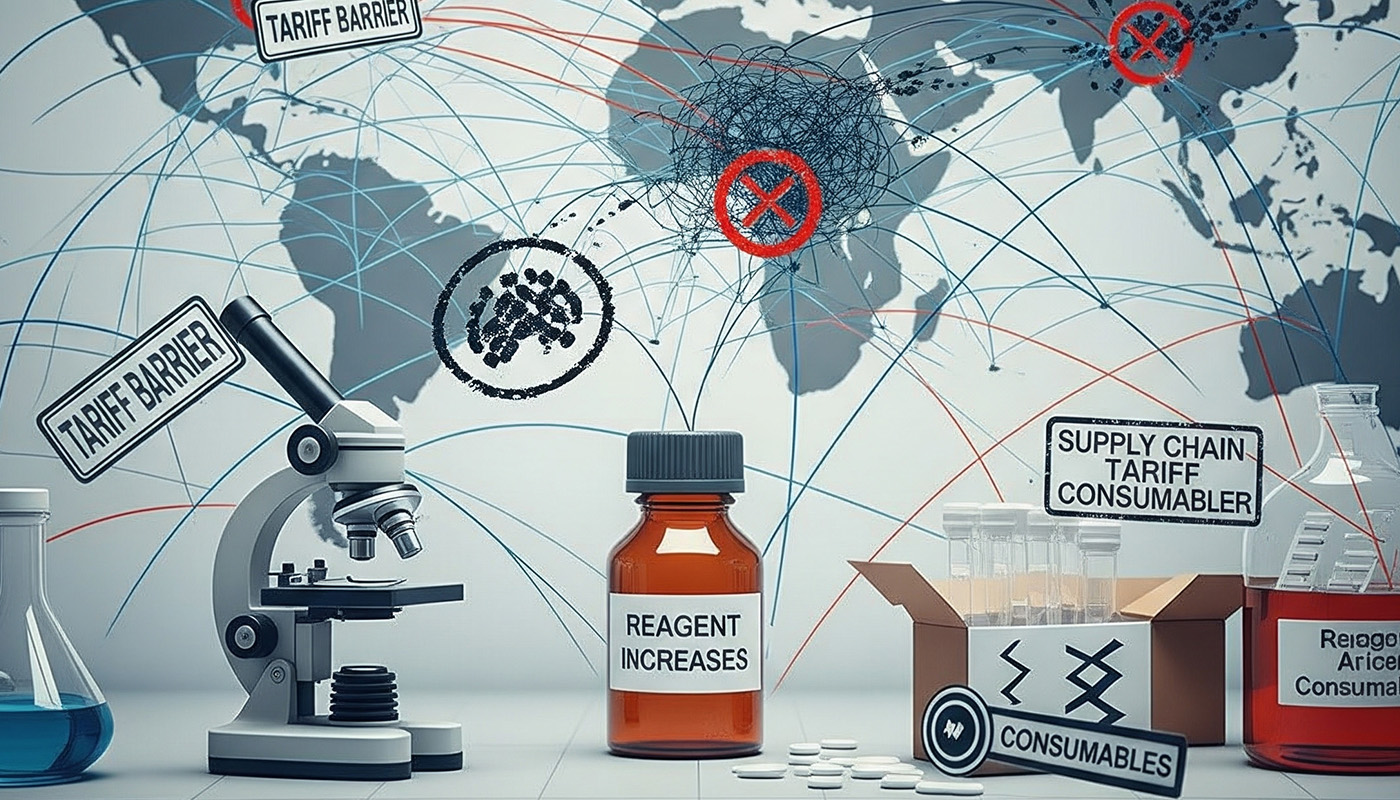TL:DR Tariffs, and their direct and indirect effects on laboratory supply chains and research, can be mitigated by using laboratory informatics systems to improve data visibility and optimize operations.
Tariffs, taxes imposed by the U.S. government on imported goods, are increasingly making global trade unpredictable. Given the intricate web of consumer markets and the specialized nature of many manufacturers, any tariff can have immediate and far-reaching effects.
Tariffs aren’t just about politics; they have tangible effects on laboratory supply chains and on the product distribution choices of the organizations those labs support. They also have more insidious indirect effects that may do lasting damage.
Imagine your lab's critical reagents are suddenly 20% more expensive, or a crucial piece of equipment is delayed by months due to unforeseen customs hurdles. This isn't a hypothetical exercise for many labs today.
This blog post provides a brief background on what tariffs are, a breakdown of their direct and indirect effects, and proactive strategies labs can use to mitigate those effects.
Understanding Tariffs: The Basics
Tariffs have been a part of American economic policy since the Tariff Act of 1789 was implemented to raise funds for the new federal government. But tariffs are much older than that—they were first used in Lagash, a Mesopotamian city, more than 4000 years ago. The name of Antwerp, Belgium, is supposedly a corruption of handwerpen, a practice they used to punish traders who wouldn’t pay their 15th-century tariffs. The Smoot–Hawley Tariff Act of 1930, signed by U.S. President Herbert Hoover during the early months of the Great Depression, is widely thought to have worsened the situation.
Tariffs have a checkered record of usefulness, often wielded by economic protectionists for what seem like good reasons at the time. But it seems clear from the lessons of history that although tariffs can solve some problems, they usually create other problems that can be more difficult to fix. Protectionism has flaws that make it unsuitable in a global economy.
To borrow a principle from game theory, and apply it to economics, consider the Prisoner’s Dilemma. Cooperation almost always beats hostility. So how can we make the best of the tariff situation, no matter how it plays out?
How Tariffs Will Affect Labs
Several types of labs in the U.S. and Canada will feel the effects of U.S.-imposed tariffs. Recent episodes of our new podcast looked at how tariffs will affect Canadian oil and gas labs and Canadian life sciences labs. To counteract some of those effects, CSols has operations in both the U.S. and Canada. This dual incorporation provides some benefits to clients because we can bill from either home country, thereby simplifying some of the financial considerations of working with consultants.
There are both direct and indirect effects of tariffs on labs in any industry. The direct costs will affect supply chains for raw materials, consumables, and infrastructure (instruments or systems). The indirect costs are more intangible, but perhaps even more impactful. These include impacts on international collaboration and partnerships, intellectual property considerations, talent acquisition and brain drain effects, regulatory complexity, and long-term innovation and competitiveness.

Direct Costs on Labs: Supply Chains and Distribution
These are tangible effects that hit the profit and loss (P&L) balance sheet immediately and disrupt daily operations. These costs include:
- Higher costs and shortages (materials, reagents, instruments, systems)
- More complex logistics and increased lead times
- Greater administrative burdens
- Reduced export competitiveness
- Increased quality control and compliance requirements
A lab relying on imported reagents from Country X might see a 15% price increase due to new tariffs, forcing them to reduce testing volume or seek more expensive domestic alternatives. Lead times for a critical mass spectrometer from an international supplier could increase by several weeks, delaying research projects and potentially impacting clinical trial timelines.
Although they are painful, these effects are often quantifiable and can be counteracted with specific procedural changes.
Effects on Research and Development
In the world of research and development (R&D), tariffs will have both direct and indirect effects. R&D labs sit at the intersection of what is and what could be. In the United States, those labs are now facing additional pressure because they are no longer funded by corporations with a vested interest in their success.
For better or worse, the era of Bell Labs and Xerox’s Palo Alto Research Center is gone. Until recently, the R&D pipeline had been filled by academic institutions funded by grant money from federal agencies. Much of this federal funding has now been cut off, making the future of innovation and clinical trials in the U.S. even more uncertain.
The R&D functions of U.S. corporations face direct budget pressure if university research dries up or becomes more expensive to access. This will lead to project delays and less innovation or to research and the related researchers moving to more conducive locations (a brain drain).
Indirect Costs for Labs: Intangible Concepts with Lasting Impacts
Labs can often react and adapt to direct tariff impacts. The indirect effects, however, erode the fundamental capacity for innovation, collaboration, and growth over time. They are harder to quantify immediately, to trace back to a single tariff action, and thus to remediate. The indirect effects have long-term consequences that undermine the core mission of many labs, especially those in research and development.
These difficulties foreground the deeper, more strategic challenges that tariffs pose and underscore the need for holistic planning, including robust data management systems. A LIMS or scientific data platform can provide visibility on processes and data needed to detect and adapt to these subtle, yet powerful, forces.
Some of the challenges of indirect tariff effects include the following
- Intellectual Property (IP) considerations
- Workforce and talent acquisition difficulties
- Regulatory and compliance complexities
- Long-term innovation and competitiveness losses
Strategies for Mitigating Tariff Impacts in Your Organization
The direct effects of tariffs can be mitigated to a certain extent with specific, quantifiable strategies. Labs can adjust budgets, seek alternative suppliers (by reshoring or diversifying), or even pass on some costs (although this has its own business risks). With direct effects, you know exactly what the problem is and can work towards a solution.
There are many ways that a laboratory informatics system can help labs optimize processes and increase efficiency to mitigate direct tariff effects. It may be possible to mitigate some of the supply chain issues by tracking the origin of all your critical materials, not just those from your direct suppliers. Analysis of your supplier data can identify single points of failure or high-risk tariff exposure. Integrating your LIMS with your enterprise resource planning (ERP) software makes this kind of information easy to get.
The indirect effects can be more challenging to address due to their intangible qualities. However, there are some ways an informatics system can help. In an era of reduced federal funding, the ability to demonstrate efficient use of resources and responsible spending is crucial for securing new grants. Labs using robust informatics systems can present clear data on their operational efficiency, cost savings initiatives, and optimized resource use, making them more attractive to funding bodies.
Informatics systems enable labs to better manage, analyze, and present their research data. This allows them to articulate the impact and value of their work more effectively in grant applications and reports, which is vital when competing for limited funds.

CSols can help customers navigate this new uncertain world by providing additional informatics system functionality or more flexible configurations, develop integrations with new systems from new suppliers, or deliver more effective data analysis and dashboards.
Taking steps such as these will help labs optimize their LIMS or other informatics systems and their data management strategies to better track inventory, manage supplier information, ensure quality control with new sources, and provide the data visibility needed to respond to tariff changes.




Comments